Text
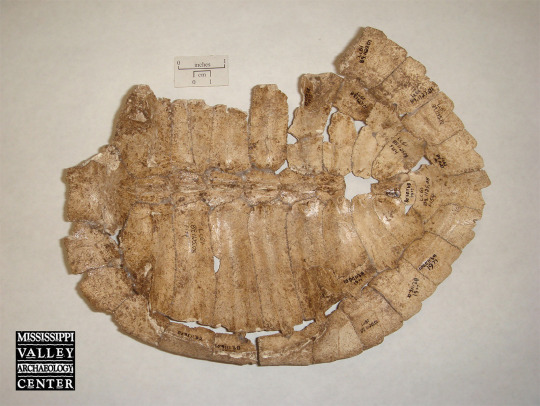
Based on archaeological recovery at precontact Native American habitation sites in western Wisconsin, turtles were sometimes harvested for their meat, with the upper shell or carapace of some species modified into containers or other utensils. The exterior carapace segments of snapping turtles often show evidence of scorching, suggesting these turtles were roasted whole for consumption, on a bed of coals. Remains of other turtle species frequently found with other food refuse, and presumed to have been dietary items, include softshell, map, false map, painted, Blanding's and ornate box turtles. The carapaces of the Blanding's and ornate box turtles have highly congruent carapace segments that when carefully cleaned of the interior vertebral column made serviceable containers. Shown here is the interior of a map turtle carapace from a La Crosse Oneota site, with the vertebrae removed and ground down to produce a plate-like artifact.
10 notes
·
View notes
Text
UWL Archaeology Alumni Podcast Series – Max Pschorr
Max Pschorr graduated from UW-La Crosse (UWL) with a BA in both Archaeological Studies and French Language in May of 2013 and worked with MVAC as a student and after graduation. Here he talks about his experience as a student field and lab tech and crew supervisor, and pursuing an interest in geographic information science (GIS)—and how his UWL connections and experience helped shape his path to a master’s degree and a GIS-focused career.
0 notes
Text
Bill Gresens’ Archaeology Book Review for May 2024
The Well of the Soul by Doug Powell (3/4 trowels)
Ancient Near East scholar Graham Eliot finds himself in grave danger as he searches for Biblical treasures rumored to be hidden in the catacombs below Jerusalem’s Temple Mount.
Read the entire review at: https://www.uwlax.edu/mvac/book-reviews/?review=298105
2 notes
·
View notes
Text
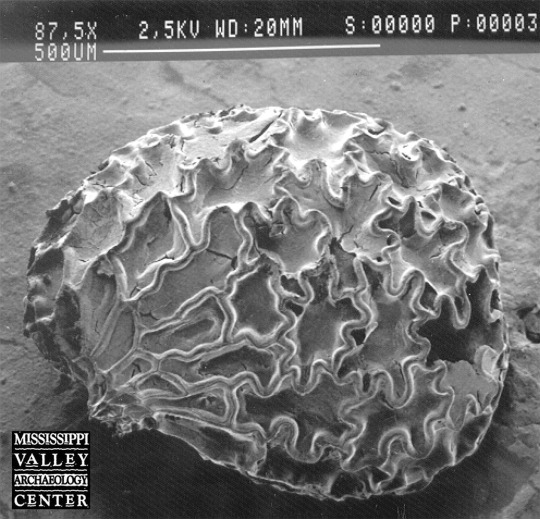
One of the things that can be recovered from light fraction flotation samples is seeds. Archaeologists spend a lot of time looking at tiny black things (charred plant remains) under a microscope, hoping to be able to identify the kind of seed. One of the most beautiful seeds that we find, and one of the very tiniest, is from tobacco. These seeds are often about half a mm across, or even smaller, but their distinctive wavy lines on the surface allow us to identify even the tiniest fragment. (Oneota, La Crosse County)
5 notes
·
View notes
Text
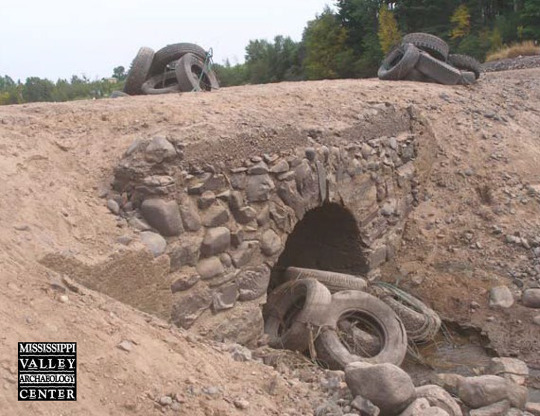
This stone arched bridge in northern Wisconsin once carried traffic over a natural stream, but it was later inundated by a reservoir, along with the surrounding area. A drawdown of the reservoir in the mid-2000s exposed the bridge and the sediment that had accumulated around it. The bridge is 6 meters (19.7 feet) wide and 2 meters (6.6 feet) across. Based on its stone construction it could date as far back as the late 1800s; however, most of the farmsteads in the area were built later, between about 1910 and 1930.
3 notes
·
View notes
Text
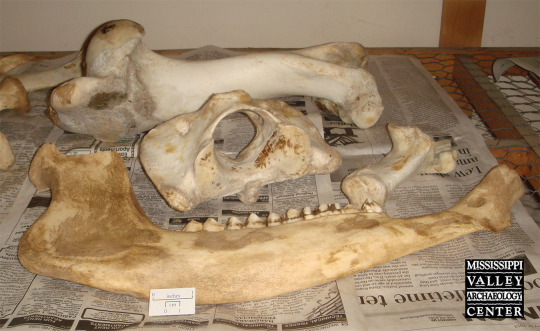
MVAC is better equipped to identify archaeological bison bones, thanks to a generous donation from long-time MVAC friend Dan Maas, who raises bison. Dan gave us a bison that died unexpectedly, as well as some additional bones. Modern comparative materials are important for accurately identifying archaeological bones. We'll be processing these bison bones and adding them to our comparative collection. Bones pictured: front, right mandible (lower jaw); center, atlas vertebra; right center, right calcaneus from lower rear leg; background, left humerus from upper front leg.
Video with more information about comparative/reference collections.
youtube
15 notes
·
View notes
Text
youtube
Bifaces: Stone Tools Worked on Both Sides
MVAC Senior Research Associate Dr. Connie Arzigian talks about bifaces—stones that have been worked on two broad sides, or faces. She describes what makes an artifact a biface and explains the stages of turning a large flake or block of stone into a tool ranging anywhere from a general-purpose knife to an intricately knapped projectile point.
3 notes
·
View notes
Text
Bill Gresens’ Archaeology Book Review for April 2024
The Sunbird by Wilbur Smith (4/4 trowels)
Master storyteller Wilbur Smith tells the story of a 20th Century African archaeology dig that has eerie origins more than 2,000 years in the past.
Link to read the entire review at: https://www.uwlax.edu/mvac/book-reviews/?review=294878
3 notes
·
View notes
Text

This vintage t-shirt dates to the early 1980s, when MVAC and UW-La Crosse undertook extensive excavations in the Sand Lake Coulee area of Onalaska, northeast of La Crosse. This large, late precontact Oneota site had tens of acres of agricultural ridged fields constructed in the dark, rich soils of a trapped floodplain. Some ridges were buried under sediment that washed down from adjacent slopes—with ridges rebuilt in the accumulating sediments. The area now has a golf course and housing developments. Link to more information about the Sand Lake ridged fields at: https://www.uwlax.edu/mvac/past-cultures/specific-sites/site-snippets/?letter=s&term=127408
5 notes
·
View notes
Text
These beer, wine, and liquor bottles from a late 19th- to early 20th-century logging camp in western Oneida County, Wisconsin, show a little variety in the beverages the occupants of the site consumed. The bottle on the far left has a slightly tapering top with a grooved ring, what is known as a brandy or wine finish. The second from the left has a straight top with a grooved ring, which is a straight brandy or wine finish, also known as a whiskey finish or a tapered collar with ring. These types of finishes were used on liquor bottles of various sizes and shapes in the latter half of the 19th century to the early 20th century (Lindsey 2021). Also among the liquor bottles was a clear base with “FULL PINT” embossed on the lower body (center left, bottom). The third bottle has a blob finish, which looks like a glob of glass had been applied to the top of the bottle. Such finishes were used on beer bottles from the 1870s to the 1910s (Lindsey 2021). The necks of these bottles have stopper closures, meaning a cork or other type of plug would have been inserted in the mouth to close the bottle. On the far right is the body and base of a dark olive green wine bottle.
Lindsey, Bill
2021 Bottle Finishes & Closures Part II: Types or Styles of Finishes. Electronic document, https://sha.org/bottle/finishes.htm, accessed March 21, 2023.

7 notes
·
View notes
Text
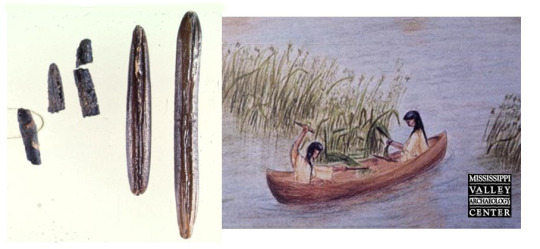
Wild rice can be recovered from light fraction flotation samples. Wild rice was a popular food with precontact peoples across northern Wisconsin and Minnesota, including the La Crosse region. Harvested by canoe, it provided an excellent source of food, especially in places where maize agriculture was not feasible. Wild rice has been found starting in the Middle Woodland Period in the Prairie du Chien area and is common at Oneota sites in the La Crosse area, where it complements the use of maize. The grains have a distinctive groove down the middle that allows archaeologists to identify even charred fragments. (left - Oneota, La Crosse County; right – modern) (drawing by Meg Rivers)
34 notes
·
View notes
Text
UWL Archaeology Alumni Podcast Series – Megan Kasten
Dr. Megan Kasten, who graduated from UW-La Crosse (UWL) in May 2012 with a BS in Archaeological Studies, talks about how a trip to Stonehenge sparked her interest in archaeology and her time at UWL inspired her to specialize in digital applications to the discipline. She also expounds on what took her to Scotland for graduate work in archaeology and the research on ogham stones that she now performs as part of the OG(H)AM project.
8 notes
·
View notes
Text
Bill Gresens’ Archaeology Book Review for March 2024
Trempealeau by John T. Umhoefer (3/4 trowels)
Mysterious things are happening in Trempealeau County, Wisconsin—in fact, the end of the world may be at hand! Can a disgraced NASA official and a retired UW-La Crosse professor save the world? Read the entire review at: https://www.uwlax.edu/mvac/book-reviews/?review=291124
1 note
·
View note
Text

These are remains from a fish called the freshwater drum (sheepshead). They were found in a refuse pit at an Oneota site in Onalaska. At the left is a pharyngeal arch—part of two matched pairs of plates in the fish’s throat, used for crushing mussels. The other four are otoliths, or “ear stones.” An otolith in each ear helps the fish with balance and movement. Two of the otoliths are burned. The three otoliths in the center are all lefts, and the one at the right is a right, from smaller fish. These right and left otoliths came from four different fish, and the pharyngeal arch represents another, smaller fish, bringing the total to five. Different sides and sizes of fish bones help us figure out how many fish are represented—the Minimum Number of Individuals, or MNI.
Freshwater drum have the largest otoliths of our freshwater fishes. The shape of drum otoliths makes them easy to identify, and their composition allows for exceptional preservation at archaeological sites. Comparing measurements of archaeological otoliths to modern specimens from fish of known weights provides a way for biologists and archaeologists to estimate size- and the contribution of drum fish to the diet. Otoliths from drum weighing 40 pounds or more have been found at La Crosse area Oneota sites.
In addition to mussels, drum eat snails and a variety of crustaceans.
6 notes
·
View notes
Text

Today, we commonly see trucks and semis haul loads over local roads and interstate highways, but people used to rely on wagons pulled by draft animals to move raw materials and finished goods. This axle and set of wheels from a historic site in Portage County, Wisconsin, are all that remain of one such wagon. The axle and wheels are encased in iron, which has rusted to a brownish gray to bright orange color. Historical research suggests that the wagon could have been used to haul wood to and from a nearby lumberyard associated with the S. H. Karner sawmill in the mid- to late 1800s. An 1884 Sanborn fire insurance map depicts a lumberyard, as well as other buildings that were part of the mill complex.
References
Nash, G.N., and F. R. Morgan
1876 Map of Portage County, Wisconsin. Milwaukee, Wisconsin.
Sanborn Map Company
1884 Stevens Point, Wisconsin. Sanborn Map and Publishing Company, New York.
Stevens Point Daily Journal
1873 Stevens Point and Its Boom. 28 May. Stevens Point, Wisconsin.
10 notes
·
View notes
Text

Woodland tradition pottery features a variety of designs incorporating stamps. These grit-tempered rims from a site in La Crosse County, Wisconsin, fall into a Middle Woodland type archaeologists call Naples Dentate Stamped. A notched tool, such as a carved stick, was pushed into the clay to create a pattern of shallow impressions. Because the tool had tooth-like notches, the stamp is called “dentate” (think “dental” or “dentist”). The sherd on the left has a row of stamp impressions near the rim made by a tool with one or more columns of notches. Below that is a row of circular punctates (holes from pushing a tool into but not completely through the clay) and then another row of stamps. The smaller sherd on the right shows similar stamping on the rim. This pottery was made about two thousand years ago.
9 notes
·
View notes
Text

Throwback Thursday – 1985 Coon Valley Survey T-Shirt
This vintage MVAC t-shirt from 1985 highlights a systematic archaeological survey conducted in the Coon Creek drainage in Vernon, La Crosse, and Monroe Counties. Headed by Robert Sasso, the project surveyed almost 2,400 acres and documented 41 private artifact collections. Before the survey, only 28 sites were recorded in the drainage; this ambitious survey added 328 more. Archaeological surveys in MVAC’s early years contributed greatly to our knowledge of the region’s past. Bob Sasso completed his doctoral dissertation based on this research at Northwestern University in 1989, and is now an Associate Professor of Anthropology at the University of Wisconsin-Parkside.
3 notes
·
View notes